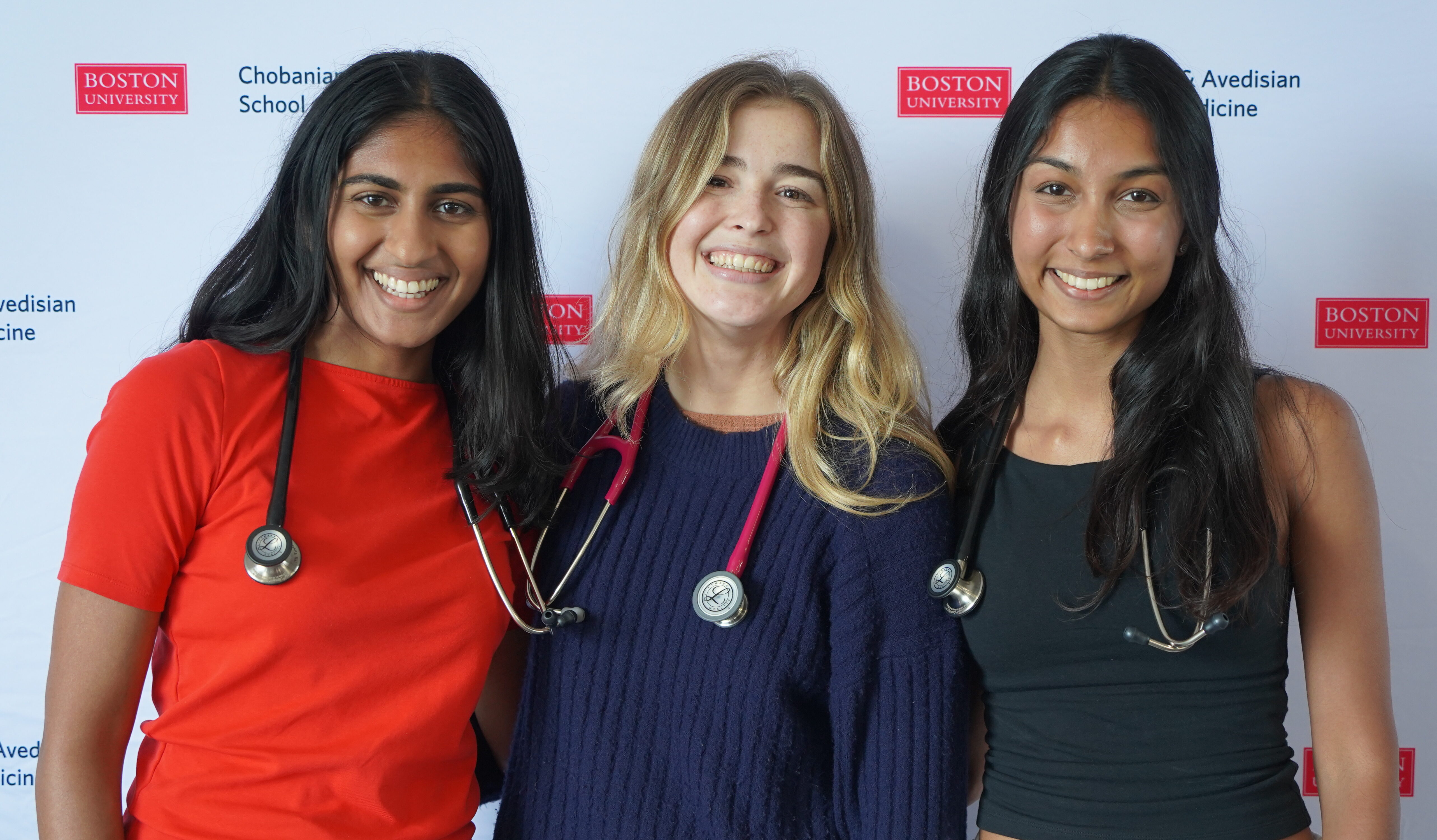Importance of the Physical Exam Highlighted at 7th Annual Stanfield Lecture
First-year medical student Anshika Gupta was planning on following the advice of Anna Hohler, MD’98, FAAN, who delivered the 7th Annual Lorraine Stanfield, MD, Memorial Doctoring Lecture on Aug. 26. Hohler, who serves as the first female chair of neurology at St. Elizabeth’s Medical Center in Brighton, told the 141 first-year medical students in attendance to take the stethoscope, ophthalmoscope, otoscope, tuning fork and reflex hammer they received as gifts from alumni donors, and practice on anyone and anything, even the family cat.
“If I had a cat, I definitely would do that, but all of my friends are would-be targets and I am going home soon and can’t wait to test it on family members,” said Gupta, who is from a Philadelphia suburb.
 First-year medical students (l-r) Ishita Rai, Marlena Coveney and Shivani Patel wearing their new stethoscopes
First-year medical students (l-r) Ishita Rai, Marlena Coveney and Shivani Patel wearing their new stethoscopes
Photo by Jake Mackey
Although physicians are now far more likely to carry these tools in the oversized pockets of their white coats than in a medical bag, they remain iconic tools of the medical trade and represent a gift from alumni welcoming them to the medical community.
“I was very excited to be receiving my stethoscope and all the other medical equipment,” said Gupta. “It truly feels like we are on the journey to being a doctor.”
The lecture was named for Lorraine Stanfield, a much-beloved member of the BU and Boston medical community, who died from breast cancer in 2017 at age 56. She spent two decades taking care of medically underserved patients at Dorchester House Health Center, now known as DotHouse Health.
“The way that she was so connected to her community is something I hope to do when I am a practicing physician,” said first-year medical student Kiel McGowan, who began medical school with a master’s in public health and hopes to work in community health.
Speakers recalled Stanfield’s affinity for medical education and the physical examination.
“She loved teaching the physical exam and the fact it could show us these clues,” said friend and co-worker Kathryn Harris, MD, an internist and primary care provider at DotHouse. She recalled that Stanfield, during an emergency room visit for her illness, talked the medical student assigned to her through her own physical examination.
“It was a pleasure to see how she took to the students and how she really cared for every individual student’s education,” said Hohler, who worked with Stanfield at BU. “She wanted to make sure that every (student)…had the opportunity to learn, not just about the theory and practice of medicine, but also to get some tangible practical experience.”
Like Stanfield, Hohler has received many BU and national teaching awards, including the medical school’s highest teaching honor, the Stanley L. Robbins Award for Excellence in Teaching. It logically followed that Hohler turned her lecture into a teaching moment by demonstrating how to conduct a physical examination, explaining the science behind one of the most familiar of patient experiences.
 Stanfield lecturer Anna Hohler, MD, FAAN, chair of neurosurgery at St. Elizabeth’s Medical Center, explains the use of the ophthalmoscope
Stanfield lecturer Anna Hohler, MD, FAAN, chair of neurosurgery at St. Elizabeth’s Medical Center, explains the use of the ophthalmoscope
Photo by Jake Mackey
“I use every one of these tools every day,” Hohler said. Although artificial intelligence and increasingly sophisticated technologies are rapidly changing modern medicine, these relatively unsophisticated tools and the physical exam are still crucial to patient care. They provide information that helps physicians pick the right test and technology; and they foster the patient/physician connection, said Hohler who compared the relationship to using a calculator while understanding the math underpinning its calculations.
“Right now, AI isn’t able to wield a reflex hammer,” said Hohler. “Being able to do these practical things in terms of the evaluation of a patient is going to serve you throughout your entire career.”
 Priya Garg, MD, associate dean of medical education, distributes packages of medical instruments, paid for by alumni donors, to first-year medical students
Priya Garg, MD, associate dean of medical education, distributes packages of medical instruments, paid for by alumni donors, to first-year medical students
Photo by Jake Mackey
For first-year medical student Annika Kamet, there still was room for both technology and the healing touch represented by the physical exam.
“I feel they give you different pieces of the puzzle, and of course it is more comforting to the patient to be able to do an examination physically, with your hands and with a stethoscope, instead of relying on (a machine),” said Kamet.
At the close of the lecture, students wrote thank-you notes to donors who financed the medical tools they received.
I’m super grateful,” said McGowan. “Medical school is expensive, so it really does make a difference.”
View all posts